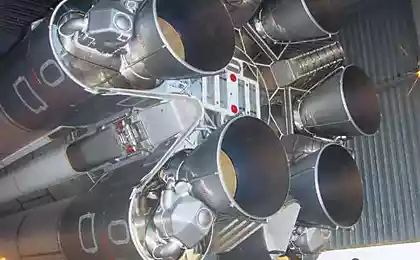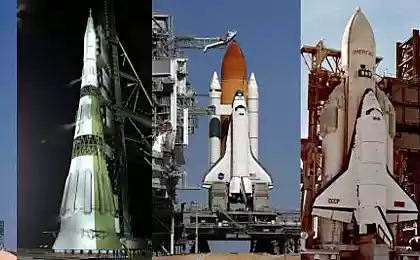2651
Where do the best rocket engines in the world
Had the opportunity to be in the company where created and create rocket engines, which extends almost the entire Soviet space program, and now pull the Russian, Ukrainian, South Korean and partly even American. Meet NGOs "Energomash", recently joined the Joint Rocket and Space Corporation Russia, a place where they make the best and most powerful liquid rocket engines in the world.

These words are not pathos. Judge for yourself: here in Khimki, developed engines for the Soviet-Russian rocket "Soyuz" and "Proton"; for the Russian "Angara"; for Soviet-Ukrainian "Zenith" and "Dnepr"; for the South Korean KSLV-1 and for the American Atlas-5 rocket. But first things first ...
After checking passports and accompanying arrival, with the entrance to the museum put forward a factory, or as it is called here "Showroom».

Keeper of the hall Vladimir Sudakov - Head of information. Apparently, with the duties he does well - he's one of my interlocutors all knew who the «Zelenyikot».

Vladimir spent a short but capacious tour in the museum.

See the table 7 centimeter pshikalku? Here she grew up with all Soviet and Russian space.
NGOs "Energomash" has evolved from a small group of enthusiasts rocket, formed in 1921, and in 1929 named Газодинамическая Laboratory , head there was a Валентин Petrovich Glushko , he later became chief designer NPO "Energomash».
Drive with a sphere in the center - is not a model of the solar system, as I thought, and layout electrorocket spacecraft. On the drive was supposed to place solar panels. In the background - the first models of liquid rocket engine development GDL.
For the first concept 20-30th. went to work on the real state financing. Here GDL has worked with the Royal ГИРД. In wartime "sharashka" developed rocket boosters for production of military aircraft. Created a whole range of engines, and believe that they are one of the world's leading liquid engine.
But all the weather spoiled the Germans, who created the first ballistic missile A4, better known in Russia under the name "V-2».
Its engine is more than an order of magnitude superior to the Soviet development (25 tons compared to 900 kg), and after the war, engineers began to catch up.
First, create a complete replica of the A4 called P-1, but using a completely Soviet materials. In this period, our engineers still helped German. But the secret development of their tried not to let, so on our own work.

The first thing the engineers began to speed up and facilitate the German design, and achieved considerable success - Rod rose to 51 ton.
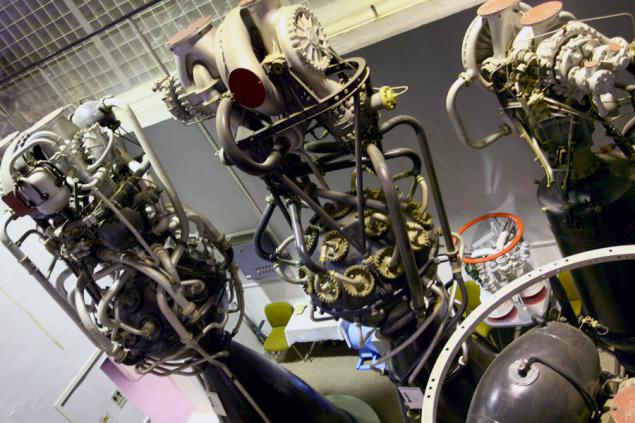
But then there were problems of instability of fuel combustion in a large spherical combustion chamber. Glushko realized that it was a dead end and engaged in the development of engines with a cylindrical chamber.

In this field he excelled. In the hands of the keeper of the museum - the first working prototype, which confirmed loyalty to the chosen scheme. What is most surprising - the inside of the combustion chamber - copper alloy. It seems that the element where the pressure exceeds hundreds of atmospheres and temperatures - a thousand degrees Celsius, it is necessary to do from some refractory titanium or tungsten. But it turned out the camera easier to cool, and not to seek unlimited thermal stability. The camera is cooled by liquid propellants, and copper was used because of its high thermal conductivity.
The first development of a new type of combustion chamber were military. In the showroom, they are hidden in the farthest and darkest corner. And the light - pride - RD-107 and RD-108, which ensured the primacy of the Soviet Union in space, and allow Russia to lead the manned space flight today.

Vladimir Sudakov shows steering camera - additional rocket engines, which allow you to control the flight.
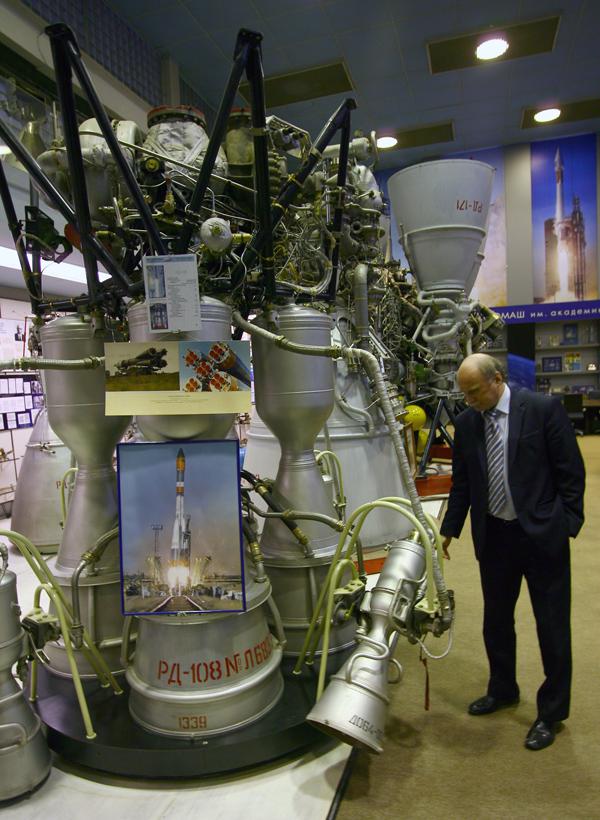
In the further development of such a structure has refused - decided to simply reject marching chamber of the engine entirely.
Problems with combustion instability in large chambers until the end to decide it was not possible, so most construction engines KB Glushko - multi-chamber.

In the hall there is only one single chamber giant, which was developed for the lunar program, but in the series and did not go - defeated a rival version of NK-33 rocket H1.

Their difference is that H1 run on kerosene-oxygen mixture and was ready to run VPGlushko people on dimethylhydrazine-nitrogen tetroxide. Such a mixture effectively, but it is much more toxic than kerosene. In Russia, it flies only cargo "Proton". However, it may however not prevent China now run their taikonaut just such a mixture.
You can look at the engine and "Proton».

A motor for a ballistic missile R-36M , still stands on duty in missiles "Voivod", commonly known as the NATO name "Satan».

However, now they are called "Dnepr" also launch for peaceful purposes.
Finally get to the gems and pride KB Glushko NPO "Energomash" - engine RD-170/171 .
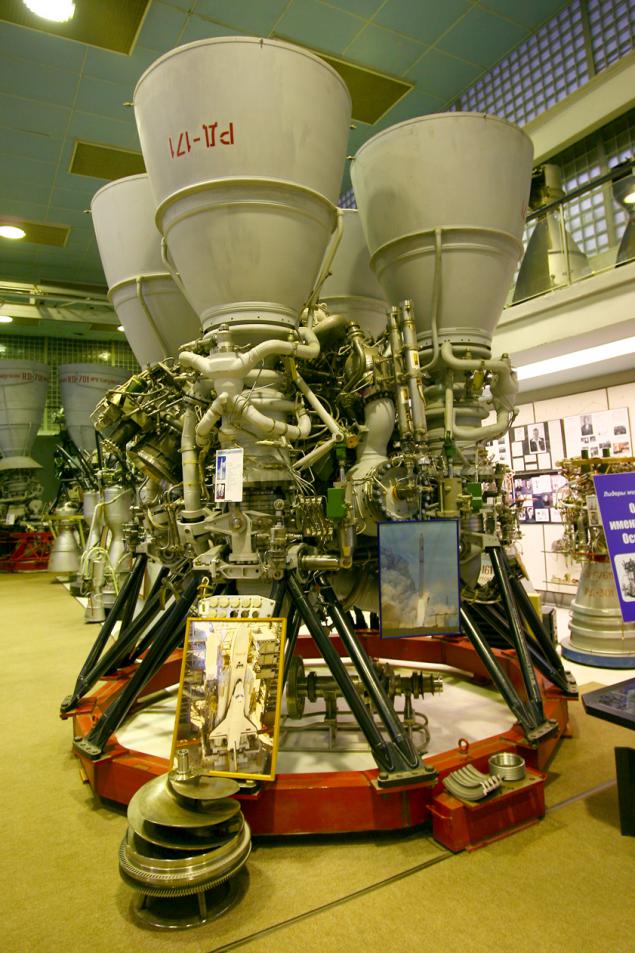
Today - is the most powerful oxygen-kerosene engine in the world - 800 ton thrust. Superior to the American lunar F-1 100 ton, but achieves this through four combustion chambers, against one of the F-1.
RD-170 is designed for the "Energia-Buran", as the engine side accelerators. The initial project was supposed reusable booster, so the engines were designed and certified for use tenfold. Unfortunately, the return accelerators have not been implemented, but the engines retain their capabilities. After closing the program "Buran" RD-170 was more fortunate than the Lunar F-1 - he found a more utilitarian use in a rocket "Zenit". In Soviet times, it just like "voivode" develops CB "South", which appeared after the collapse of the USSR abroad. But in the 90's policy did not prevent the Russian-Ukrainian cooperation, and by 1995, together with the United States and Norway began to implement the project & quot; Морской Start & quot ;. Although he was never released on profitability, was reorganized and is now being decided his fate, but the rocket flew and maintained orders for engines "Energomash" lack of money during the space 90 x early 2000s.
Vladimir Sudakov shows a fantastic development engineers "Energomash" - an integral bellows unit swing engine.

How to achieve node mobility at high pressures and extreme temperatures? Yes garbage question: only 12 metal layers and additional rings booking, fill it between layers of liquid oxygen and no problems ...
This design allows rigidly fix the engine, but to control the flight deviation of the combustion chamber and nozzle using a gimbal. On the engine it is visible just below and right of center, above the panel with red caps.

Americans about his space like to say, "We stand on the shoulders of giants." Looking at such creations of Soviet engineers know that this phrase refers exclusively to the Russian space program. The same "Angara", though already brainchild of Russian designers, but its engine - RD-191 goes back to the evolutionary RD-171.

Similarly, "half" of the RD-171, called RD-180 has contributed to, and in the American space program, when "Energomash" in 1995 won the competition Lockheed Martin. I asked if there was any in this victory propaganda element - could the Americans to sign a contract with the Russian, to demonstrate completion of an era of competition and the beginning of cooperation in space. I did not answer, but his eyes told about ofigevshie American customers, when they saw the creation of a gloomy Khimki genius. According to rumors, the characteristics of the RD-180 is almost twice the characteristics of the competition. The reason is that the US has not mastered the rocket engines with закрытым cycle . In principle, it is possible and without it, the same F-1 was an open-loop or Merlin by SpaceX. But in the ratio of "power / weight" closed-cycle engines win, though losing in price.
Here in the video engine test Merlin-1D shows how out of the tube near the nozzle gushing stream generator gas:
In this closed loop gas back into the combustion chamber, allowing for more efficient use of fuel. The museum is set separately rotor booster pump unit oxidant. These rotors are more than once we will meet on the tour of the NGO "Energomash».

Finally, the completion of the exposure - the hope of the enterprise - RD-191. This is still the youngest model family. It was created for the rocket "Angara", has worked in the Korean KSLV-1, and it considers to be one of the variants of the American company Orbital Scienses, which need to be replaced Samara NK-33 after the accident rocket Antares in October.
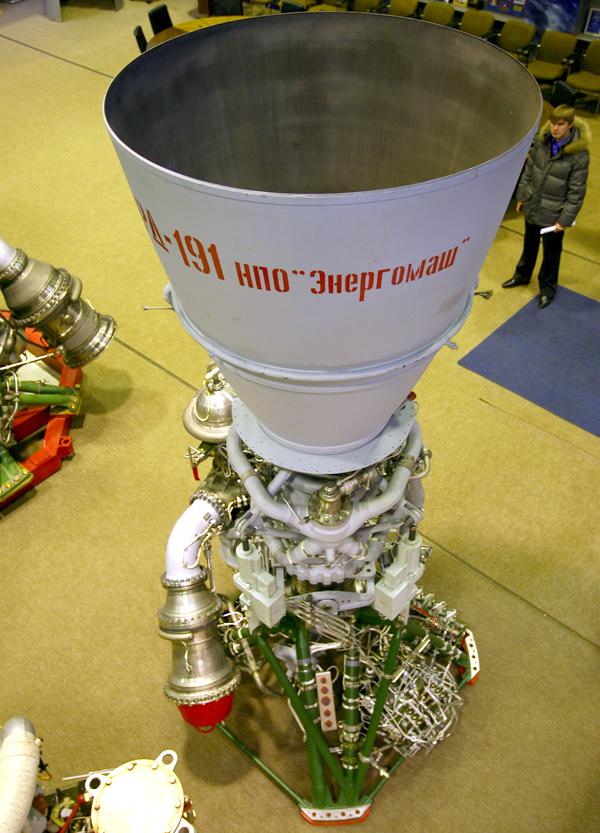
At the factory the trio RD-170, RD-180, RD-191 is jokingly called "liter", "pint" and "quartered».
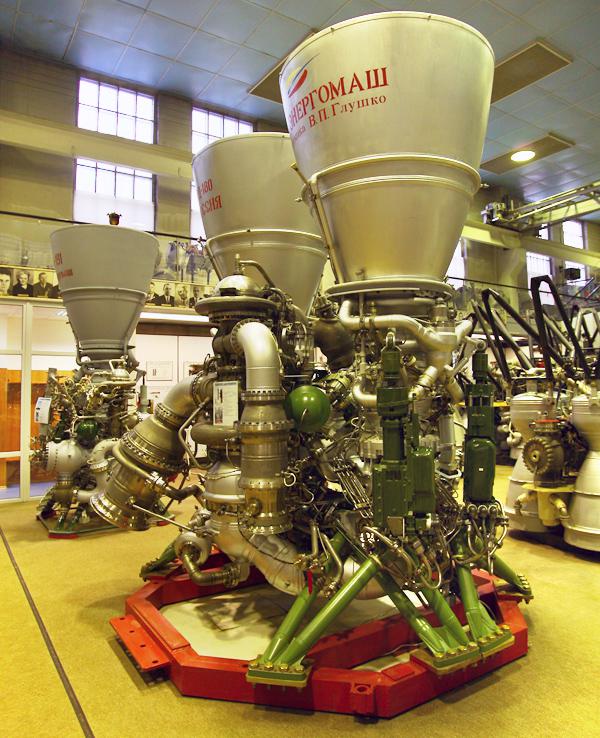
Wow, something the volume turned tour. Let's postpone the inspection of the plant the next day. There's also a lot of interesting, and most importantly get to see how such an engineering marvel created from a pile of steel and aluminum ingots.
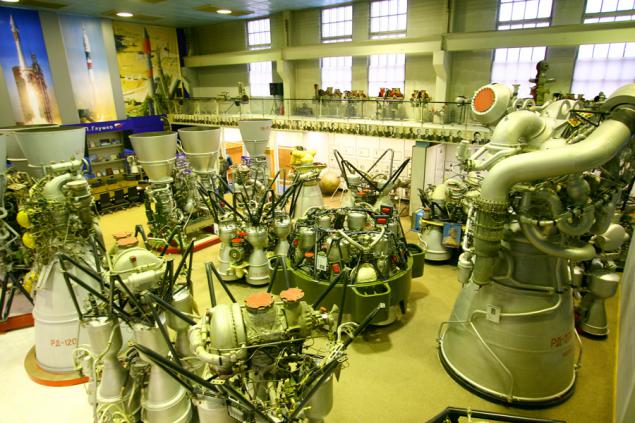
I express my gratitude to the Department of Information Policy and Media Joint Rocket and Space Corporation and the press service of the NPO "Energomash" for assistance in organizing the filming i>.
Source: geektimes.ru/post/242643/

These words are not pathos. Judge for yourself: here in Khimki, developed engines for the Soviet-Russian rocket "Soyuz" and "Proton"; for the Russian "Angara"; for Soviet-Ukrainian "Zenith" and "Dnepr"; for the South Korean KSLV-1 and for the American Atlas-5 rocket. But first things first ...
After checking passports and accompanying arrival, with the entrance to the museum put forward a factory, or as it is called here "Showroom».

Keeper of the hall Vladimir Sudakov - Head of information. Apparently, with the duties he does well - he's one of my interlocutors all knew who the «Zelenyikot».

Vladimir spent a short but capacious tour in the museum.

See the table 7 centimeter pshikalku? Here she grew up with all Soviet and Russian space.
NGOs "Energomash" has evolved from a small group of enthusiasts rocket, formed in 1921, and in 1929 named Газодинамическая Laboratory , head there was a Валентин Petrovich Glushko , he later became chief designer NPO "Energomash».
Drive with a sphere in the center - is not a model of the solar system, as I thought, and layout electrorocket spacecraft. On the drive was supposed to place solar panels. In the background - the first models of liquid rocket engine development GDL.
For the first concept 20-30th. went to work on the real state financing. Here GDL has worked with the Royal ГИРД. In wartime "sharashka" developed rocket boosters for production of military aircraft. Created a whole range of engines, and believe that they are one of the world's leading liquid engine.
But all the weather spoiled the Germans, who created the first ballistic missile A4, better known in Russia under the name "V-2».
Its engine is more than an order of magnitude superior to the Soviet development (25 tons compared to 900 kg), and after the war, engineers began to catch up.
First, create a complete replica of the A4 called P-1, but using a completely Soviet materials. In this period, our engineers still helped German. But the secret development of their tried not to let, so on our own work.

The first thing the engineers began to speed up and facilitate the German design, and achieved considerable success - Rod rose to 51 ton.

But then there were problems of instability of fuel combustion in a large spherical combustion chamber. Glushko realized that it was a dead end and engaged in the development of engines with a cylindrical chamber.

In this field he excelled. In the hands of the keeper of the museum - the first working prototype, which confirmed loyalty to the chosen scheme. What is most surprising - the inside of the combustion chamber - copper alloy. It seems that the element where the pressure exceeds hundreds of atmospheres and temperatures - a thousand degrees Celsius, it is necessary to do from some refractory titanium or tungsten. But it turned out the camera easier to cool, and not to seek unlimited thermal stability. The camera is cooled by liquid propellants, and copper was used because of its high thermal conductivity.
The first development of a new type of combustion chamber were military. In the showroom, they are hidden in the farthest and darkest corner. And the light - pride - RD-107 and RD-108, which ensured the primacy of the Soviet Union in space, and allow Russia to lead the manned space flight today.

Vladimir Sudakov shows steering camera - additional rocket engines, which allow you to control the flight.

In the further development of such a structure has refused - decided to simply reject marching chamber of the engine entirely.
Problems with combustion instability in large chambers until the end to decide it was not possible, so most construction engines KB Glushko - multi-chamber.

In the hall there is only one single chamber giant, which was developed for the lunar program, but in the series and did not go - defeated a rival version of NK-33 rocket H1.

Their difference is that H1 run on kerosene-oxygen mixture and was ready to run VPGlushko people on dimethylhydrazine-nitrogen tetroxide. Such a mixture effectively, but it is much more toxic than kerosene. In Russia, it flies only cargo "Proton". However, it may however not prevent China now run their taikonaut just such a mixture.
You can look at the engine and "Proton».

A motor for a ballistic missile R-36M , still stands on duty in missiles "Voivod", commonly known as the NATO name "Satan».

However, now they are called "Dnepr" also launch for peaceful purposes.
Finally get to the gems and pride KB Glushko NPO "Energomash" - engine RD-170/171 .

Today - is the most powerful oxygen-kerosene engine in the world - 800 ton thrust. Superior to the American lunar F-1 100 ton, but achieves this through four combustion chambers, against one of the F-1.
RD-170 is designed for the "Energia-Buran", as the engine side accelerators. The initial project was supposed reusable booster, so the engines were designed and certified for use tenfold. Unfortunately, the return accelerators have not been implemented, but the engines retain their capabilities. After closing the program "Buran" RD-170 was more fortunate than the Lunar F-1 - he found a more utilitarian use in a rocket "Zenit". In Soviet times, it just like "voivode" develops CB "South", which appeared after the collapse of the USSR abroad. But in the 90's policy did not prevent the Russian-Ukrainian cooperation, and by 1995, together with the United States and Norway began to implement the project & quot; Морской Start & quot ;. Although he was never released on profitability, was reorganized and is now being decided his fate, but the rocket flew and maintained orders for engines "Energomash" lack of money during the space 90 x early 2000s.
Vladimir Sudakov shows a fantastic development engineers "Energomash" - an integral bellows unit swing engine.

How to achieve node mobility at high pressures and extreme temperatures? Yes garbage question: only 12 metal layers and additional rings booking, fill it between layers of liquid oxygen and no problems ...
This design allows rigidly fix the engine, but to control the flight deviation of the combustion chamber and nozzle using a gimbal. On the engine it is visible just below and right of center, above the panel with red caps.

Americans about his space like to say, "We stand on the shoulders of giants." Looking at such creations of Soviet engineers know that this phrase refers exclusively to the Russian space program. The same "Angara", though already brainchild of Russian designers, but its engine - RD-191 goes back to the evolutionary RD-171.

Similarly, "half" of the RD-171, called RD-180 has contributed to, and in the American space program, when "Energomash" in 1995 won the competition Lockheed Martin. I asked if there was any in this victory propaganda element - could the Americans to sign a contract with the Russian, to demonstrate completion of an era of competition and the beginning of cooperation in space. I did not answer, but his eyes told about ofigevshie American customers, when they saw the creation of a gloomy Khimki genius. According to rumors, the characteristics of the RD-180 is almost twice the characteristics of the competition. The reason is that the US has not mastered the rocket engines with закрытым cycle . In principle, it is possible and without it, the same F-1 was an open-loop or Merlin by SpaceX. But in the ratio of "power / weight" closed-cycle engines win, though losing in price.
Here in the video engine test Merlin-1D shows how out of the tube near the nozzle gushing stream generator gas:
In this closed loop gas back into the combustion chamber, allowing for more efficient use of fuel. The museum is set separately rotor booster pump unit oxidant. These rotors are more than once we will meet on the tour of the NGO "Energomash».

Finally, the completion of the exposure - the hope of the enterprise - RD-191. This is still the youngest model family. It was created for the rocket "Angara", has worked in the Korean KSLV-1, and it considers to be one of the variants of the American company Orbital Scienses, which need to be replaced Samara NK-33 after the accident rocket Antares in October.

At the factory the trio RD-170, RD-180, RD-191 is jokingly called "liter", "pint" and "quartered».

Wow, something the volume turned tour. Let's postpone the inspection of the plant the next day. There's also a lot of interesting, and most importantly get to see how such an engineering marvel created from a pile of steel and aluminum ingots.

I express my gratitude to the Department of Information Policy and Media Joint Rocket and Space Corporation and the press service of the NPO "Energomash" for assistance in organizing the filming i>.
Source: geektimes.ru/post/242643/

